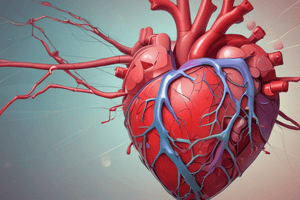Podcast
Questions and Answers
What is a contraindication for anticoagulants ?
What is a contraindication for anticoagulants ?
- Hypotension
- History of stroke
- Recent surgery (correct)
- Migraine headaches
What is the therapeutic range for Partial Thromboplastin Time (PTT) when using heparins?
What is the therapeutic range for Partial Thromboplastin Time (PTT) when using heparins?
- 45-70 seconds (correct)
- 30-45 seconds
- 110-130 seconds
- 80-100 seconds
What is the antidote for low-molecular-weight heparins like enoxaparin?
What is the antidote for low-molecular-weight heparins like enoxaparin?
- Vitamin K
- Alteplase
- Warfarin
- Protamine sulfate (correct)
What is the target International Normalized Ratio (INR) for vitamin K antagonists like warfarin?
What is the target International Normalized Ratio (INR) for vitamin K antagonists like warfarin?
What can be used to reverse the effects of vitamin K antagonists?
What can be used to reverse the effects of vitamin K antagonists?
What is a key advantage of direct-acting oral anticoagulants (DOACs) like dabigatran and rivaroxaban?
What is a key advantage of direct-acting oral anticoagulants (DOACs) like dabigatran and rivaroxaban?
In which conditions are thrombolytics like alteplase used to reestablish blood flow?
In which conditions are thrombolytics like alteplase used to reestablish blood flow?
What is a contraindication for thrombolytics?
What is a contraindication for thrombolytics?
What is a potential adverse effect of thrombolytics?
What is a potential adverse effect of thrombolytics?
What should patients taking blood thinners do to prevent injury?
What should patients taking blood thinners do to prevent injury?
In the given patient scenario, what does pain and swelling in the leg after flying indicate?
In the given patient scenario, what does pain and swelling in the leg after flying indicate?
What sections of the Google Form need to be completed based on the patient scenario?
What sections of the Google Form need to be completed based on the patient scenario?
What is the normal range for platelet count in primary hemostasis?
What is the normal range for platelet count in primary hemostasis?
Where does the activation of the intrinsic pathway of the coagulation cascade occur?
Where does the activation of the intrinsic pathway of the coagulation cascade occur?
What is the normal range for Prothrombin Time (PT) in secondary hemostasis?
What is the normal range for Prothrombin Time (PT) in secondary hemostasis?
What is the potential adverse effect of heparin therapy that is a potentially life-threatening complication?
What is the potential adverse effect of heparin therapy that is a potentially life-threatening complication?
What is the goal of using heparins in patients with disseminated intravascular coagulation (DIC)?
What is the goal of using heparins in patients with disseminated intravascular coagulation (DIC)?
What is the lifespan of platelets?
What is the lifespan of platelets?
What is the normal range for Activated partial Thrombin Time (aPTT) in secondary hemostasis?
What is the normal range for Activated partial Thrombin Time (aPTT) in secondary hemostasis?
What is the function of endothelial cells in hemostasis?
What is the function of endothelial cells in hemostasis?
What is the primary goal of hemostasis?
What is the primary goal of hemostasis?
Where does the activation of the intrinsic pathway of the coagulation cascade occur?
Where does the activation of the intrinsic pathway of the coagulation cascade occur?
What is the normal range for activated partial thrombin time (aPTT)?
What is the normal range for activated partial thrombin time (aPTT)?
What is the potential complication associated with heparin use?
What is the potential complication associated with heparin use?
What is the role of endothelial cells in hemostasis?
What is the role of endothelial cells in hemostasis?
What is the function of D-dimer in hemostasis?
What is the function of D-dimer in hemostasis?
What is the lifespan of platelets in the blood?
What is the lifespan of platelets in the blood?
What is the main therapeutic goal in disseminated intravascular coagulation (DIC)?
What is the main therapeutic goal in disseminated intravascular coagulation (DIC)?
Match the following components of hemostasis with their functions:
Match the following components of hemostasis with their functions:
Match the following coagulation lab values with their normal ranges:
Match the following coagulation lab values with their normal ranges:
Match the following therapeutic uses with the corresponding conditions:
Match the following therapeutic uses with the corresponding conditions:
Match the following side/adverse effects of heparins with their descriptions:
Match the following side/adverse effects of heparins with their descriptions:
Match the following terms with their descriptions:
Match the following terms with their descriptions:
Match the anticoagulant with its antidote:
Match the anticoagulant with its antidote:
Match the potential adverse effect with the corresponding anticoagulant/thrombolytic:
Match the potential adverse effect with the corresponding anticoagulant/thrombolytic:
Match the contraindication with the corresponding anticoagulant/thrombolytic:
Match the contraindication with the corresponding anticoagulant/thrombolytic:
Match the monitoring requirement with the corresponding anticoagulant:
Match the monitoring requirement with the corresponding anticoagulant:
Match the potential complication with the corresponding anticoagulant:
Match the potential complication with the corresponding anticoagulant:
Flashcards are hidden until you start studying
Study Notes
Anticoagulants and Thrombolytics: Key Points
- Anticoagulants like argatroban have contraindications including active bleeding, recent surgery, severe hypertension, and severe kidney or liver disease
- Heparins have a narrow therapeutic window and require monitoring of labs, with a therapeutic PTT of 45-70 seconds
- Low-molecular-weight heparins like enoxaparin have a more predictable response, no need for blood coagulation monitoring, and an antidote of protamine sulfate
- Vitamin K antagonists like warfarin prevent synthesis of vitamin K-dependent clotting factors and have a narrow therapeutic window, with a target INR of 2-3
- Vitamin K antagonists have interactions with medications and foods high in vitamin K and can be reversed with phytonadione or prothrombin complex concentrate
- Direct-acting oral anticoagulants (DOACs) like dabigatran and rivaroxaban have advantages including less variability in drug effect and may become the first choice for oral anticoagulants
- Thrombolytics like alteplase break unwanted blood clots and are used to reestablish blood flow in conditions such as MI, PE, and CVA
- Thrombolytics have contraindications including aneurysms, known coagulopathy, or internal bleeding, and should be administered within 3-4.5 hours after onset of symptoms
- Thrombolytics have adverse effects such as bleeding and require careful selection of recipients, with precautions for older patients, those taking anticoagulants, and those with hypertension
- Thrombolytic therapy should be performed by experienced personnel, with monitoring of vital signs, bleeding symptoms, and laboratory tests
- Patients taking blood thinners should implement safety precautions to prevent injury and report any signs of bleeding, and should take medication as directed to avoid complications
- In the patient scenario, Mr. Phib presents with pain and swelling in his leg after flying, indicating a potential thrombotic event, and the ER visit and re-hospitalization sections of the Google Form need to be completed.
Anticoagulants and Thrombolytics: Key Points
- Anticoagulants like argatroban have contraindications including active bleeding, recent surgery, severe hypertension, and severe kidney or liver disease
- Heparins have a narrow therapeutic window and require monitoring of labs, with a therapeutic PTT of 45-70 seconds
- Low-molecular-weight heparins like enoxaparin have a more predictable response, no need for blood coagulation monitoring, and an antidote of protamine sulfate
- Vitamin K antagonists like warfarin prevent synthesis of vitamin K-dependent clotting factors and have a narrow therapeutic window, with a target INR of 2-3
- Vitamin K antagonists have interactions with medications and foods high in vitamin K and can be reversed with phytonadione or prothrombin complex concentrate
- Direct-acting oral anticoagulants (DOACs) like dabigatran and rivaroxaban have advantages including less variability in drug effect and may become the first choice for oral anticoagulants
- Thrombolytics like alteplase break unwanted blood clots and are used to reestablish blood flow in conditions such as MI, PE, and CVA
- Thrombolytics have contraindications including aneurysms, known coagulopathy, or internal bleeding, and should be administered within 3-4.5 hours after onset of symptoms
- Thrombolytics have adverse effects such as bleeding and require careful selection of recipients, with precautions for older patients, those taking anticoagulants, and those with hypertension
- Thrombolytic therapy should be performed by experienced personnel, with monitoring of vital signs, bleeding symptoms, and laboratory tests
- Patients taking blood thinners should implement safety precautions to prevent injury and report any signs of bleeding, and should take medication as directed to avoid complications
- In the patient scenario, Mr. Phib presents with pain and swelling in his leg after flying, indicating a potential thrombotic event, and the ER visit and re-hospitalization sections of the Google Form need to be completed.
Studying That Suits You
Use AI to generate personalized quizzes and flashcards to suit your learning preferences.




